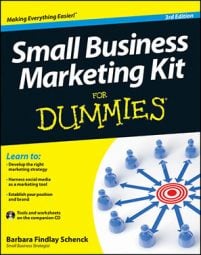Public relations (PR) is about getting your small business noticed by customers, business partners, and prospects. Develop a working public relations plan to target specific audiences with your small business marketing message.
The Public Relations Society of America defines public relations as activities that “help an organization and its public adapt mutually to each other.” Other professionals say that public relations involves activities that aim to establish, maintain, and improve a favorable relationship with the public upon which an organization’s success depends.
In the small business marketing arena, public relations means doing the right thing and then talking about it — using publicity and other nonpaid communication opportunities to inform those whose positive opinions favorably affect your business.
Here’s a list of the different areas of public relations and what each one does:
Media relations: Establish editorial contacts, distribute news releases and story ideas, and become a reliable and trustworthy news source by providing guest posts and editorials and participating in media interviews, forums, and events. Publicity is part of media relations, and media relations is part of — but not all of — public relations.
Employee or member relations: Use newsletters, meetings, events, and programs to interact with internal audiences and to demonstrate that your company’s interest in doing the right thing starts at home.
Community relations: Build ties to your local market area by joining groups, serving on boards, spearheading charitable endeavors, and donating time, products, services, or funds to causes and projects that benefit your community. As you undertake community relations efforts, do so first because you believe in the cause and second for the visibility you receive as a good community citizen.
Industry relations: Join industry associations, participate in industry events, and serve as an officeholder in groups that represent your business arena. A strong industry role keeps your business in the forefront and establishes your credibility with colleagues, consumers, and editorial contacts.
Government relations: Build relationships with elected officials. Acquaint them with your company so they have a favorable impression should they be asked to comment on your business or should you need their help in the future. (Just as with bankers, it’s good to make friends with politicians long before you need their help.)
Issue- and crisis-management: Sometimes, news about your business is confusing, and once in a while, it may even threaten your image. One function of public relations is to explain and build support for complex issues and to manage crises when they arise.
When you get mentioned in the media, that’s publicity. It sounds so simple, but a surprising amount of planning and effort goes on behind the scenes before a company gets a “free” mention in a newspaper or magazine, on a blog or social media page, in a TV or radio story, or even in another company’s newsletter.
Those who spend much time generating publicity will tell you that the results of their efforts are valuable but hardly free. It takes both time and money to develop news stories, make and maintain media contacts, stage events, and implement programs worthy of editorial coverage.
But each time you succeed in generating positive publicity, you score a triple victory. First, you win valuable editorial mentions in mass-media vehicles. Second, you win consumer confidence, as people tend to believe the editorial content of mass media more than they do paid advertising messages.
The third benefit of positive publicity is that it generates third-party mentions and features that you can share in social networks and newsletters and reprint to distribute via direct mailings, sales presentations, and press kits.

